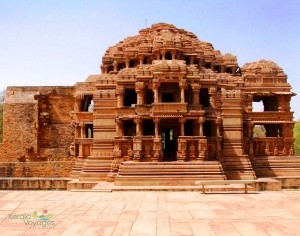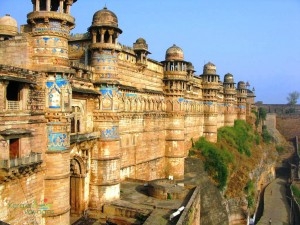 Gwalior’s tradition as a royal capital continued until the formation of present day India, with the Scindias having their dynastic seat here. The magnificent mementoes of a glorious past have been preserved with care, giving Gwalior an appeal unique and timeless. Gwalior’s history is traced back to a legend. In 8 A.D, a chieftain called SurajSen was stricken by a deadly disease. He was cured by a hermit saint, Gwalipa, and in gratitude founded a city which he named after the saint who had given him the gift of new life. The new city of Gwalior became, over the centuries, the cradle of great dynasties and with each, the city gained new dimensions from warrior kings, poets, musicians and saints, contributing to making it a capital renowned throughout the country.Since then, Gwalior is considered to be a city where a rich cultural tradition has been interwoven into the fabric of modern life. Also where a princely past lives on in great palaces and their museums. And where a multitude of images merge and mix to present to the visitor a city of enduring greatness.
Gwalior’s tradition as a royal capital continued until the formation of present day India, with the Scindias having their dynastic seat here. The magnificent mementoes of a glorious past have been preserved with care, giving Gwalior an appeal unique and timeless. Gwalior’s history is traced back to a legend. In 8 A.D, a chieftain called SurajSen was stricken by a deadly disease. He was cured by a hermit saint, Gwalipa, and in gratitude founded a city which he named after the saint who had given him the gift of new life. The new city of Gwalior became, over the centuries, the cradle of great dynasties and with each, the city gained new dimensions from warrior kings, poets, musicians and saints, contributing to making it a capital renowned throughout the country.Since then, Gwalior is considered to be a city where a rich cultural tradition has been interwoven into the fabric of modern life. Also where a princely past lives on in great palaces and their museums. And where a multitude of images merge and mix to present to the visitor a city of enduring greatness.
The entire city is a visual and aesthetic feast, for the builders of Gwalior were great architects. Take a walk through the streets of the city and you will discover old havelis with exquisitely carved doorways and windows; at almost every street crossing you will find statues of the Scindia family. Museums and art galleries are treasure houses and beautifully maintained palaces give the city its inimitable regal flavour. Sightseeing in Gwalior is a magical trip into the centuries gone by.
The Fort
Standing on a steep mass of sandstone, Gwalior Fort dominates the city and is its most magnificent monument. It has been a scene of momentous events : imprisonments, battles and jauhars. A steep
 road winds upwards to the Fort, flanked by statues of Jain tirthankaras, carved into the rock face. The magnificent outer walls of the Fort still stand, two miles in length and 35 feet high, bearing witness to its reputation for being one of the most invincible forts of India. This imposing structure inspired Emperor Babar to describe it “the pearl amongst the fortresses of Hind.” Within the fort are some marvels of medieval architecture. The 15th century GujariMahal is a monument to the love of Raja MansinghTomar for his Gujar queen, Mrignayani. After he had wooed and won her, so the story goes, Mrignayani demanded that he build her a separate palace with a constant water supply from the River Rai, via an aqueduct. The outer structure of the GujariMahal has survived in an almost total state of preservation; the interior has been converted into an Archaeological Museum.
road winds upwards to the Fort, flanked by statues of Jain tirthankaras, carved into the rock face. The magnificent outer walls of the Fort still stand, two miles in length and 35 feet high, bearing witness to its reputation for being one of the most invincible forts of India. This imposing structure inspired Emperor Babar to describe it “the pearl amongst the fortresses of Hind.” Within the fort are some marvels of medieval architecture. The 15th century GujariMahal is a monument to the love of Raja MansinghTomar for his Gujar queen, Mrignayani. After he had wooed and won her, so the story goes, Mrignayani demanded that he build her a separate palace with a constant water supply from the River Rai, via an aqueduct. The outer structure of the GujariMahal has survived in an almost total state of preservation; the interior has been converted into an Archaeological Museum.The Sound and Lights Show, Gwalior Fort
For many decades now, the Fort of Gwalior has slumbered in silence, broken now and then by the patter of curious feet and awed tones.Come sundown, the deserted Fort is once again left with only memories for company. But now it comes alive every night. Well remembered incidents, and well-loved voices once more echo through its lonely corridors and its dark and sad facade now glows with the colours of life. Red-gold, blue-green lights illuminate every nook and cranny of the superbly tiled ‘Man Mandir’. The Gwalior Son-et-Lumiere has begun. The Sound and Light show at the Man Mandir Palace of Gwalior Fort gives you a glimpse into its glorious past. The story of this ‘pearl’ begins with the sonorous and eloquent narration by Amitabh Bachchan as Gopachal, the sutradhar (narrator)..
Teli ka Mandir
The Teli ka Mandir is a 9th century edifice, towering at 100 ft high. This is a Pratihara Vishnu temple of a unique blending of architectural styles. The shape of the roof is distinctively Dravidian, while the decorative embellishments have the typically Indo-Aryan characteristics of Northern India. Also dedicated to Vishnu is the graceful little Sas-Bahu-ka-Mandir, built in 11th century. Another landmark is the historic Gurudwara Data BandhiChhod built in the memory of Guru Hargobind Sahib, the 6th Sikh Guru who was imprisoned here by Jehangir for over two years. At the time of his release, he wanted 52 Hindu kings who were his fellow prisoners, released with him. Jehangir was very impressed with the Guru and agreed to his condition. And, finally, within the Fort complex, housed in the erstwhile barracks of the British soldiers, is Gwalior’s unique gift to modern India :Scindia School. Acknowledged as one of the finest schools in India, it is only fitting that the country’s young citizens receive the best educational grounding surrounded by monuments to a past which is a constant inspiration.
Jai Vilas Palace
A splendour of a different kind exists in the Jai Vilas Palace, current residence of the Scindia family. Some 35 rooms have been made into the Scindia Museum, and in these rooms, so evocative of a regal lifestyle, the past comes alive. Jai Vilas is an Italianate structure which combines the Tuscan and Corinthian architectural modes. The imposing Darbar Hall has two central chandeliers, weighing a couple of tonnes, and hung only after ten elephants had tested the strength of the roof. Ceilings picked out in gilt, heavy draperies and tapestries, fine Persian carpets, and antique furniture from France and Italy are features of these spacious rooms. Eye-catching treasures include: a silver train with cut-glass wagons which served guests as it chugged around on miniature rails on the tables; a glass cradle from Italy used for the baby Krishna each Janamashtami; silver dinner services and swords that were once worn by Aurangzeb and Shah Jehan.There are, besides, personal mementoes of the past members of the Scindia family: the jewelled slippers that belonged to Chinkoo Rani, four-poster beds, gifts from practically every country in the world, hunting trophies and portraits. The Scindia Museum offers an unparalleled glimpse into the rich culture and lifestyle of princely India. Open everyday except Wednesday from 10 am to 5.30 pm.
Monuments
The father of Hindustani classical music, the great Tansen, one of the ‘nine Jewels’ of Akbar’s court, lies buried in Gwalior. The memorial to this great musician has a pristine simplicity about it, and is built in the early Mughal architectural style. More than a monument, the Tansen’s Tomb is part of Gwalior’s living cultural heritage; it is the venue of a music festival on a national scale held annually in November-December. Leading musicians of the country gather here to give performances during the festival. More opulent than Tansen’s Tomb, is the sandstone mausoleum of the Afghan prince, Ghous Mohammed, also designed on early Mughal lines. Particularly, exquisite are the screens which use the pierced stone technique, as delicate as lace. The earliest freedom fighters, Tatya Tope and the indomitable Rani of Jhansi, are commemorated in memorials in Gwalior. There are cenotaphs at major public crossings, memorials to Scindia kings and queens. Throughout the city, there are these reminders of a proud past, of the great men and women of Gwalior who have their place in the nation’s roll of honour. Located near the Residency at Morar, the newly constructed Sun Temple takes its inspiration from the famous Konark Sun Temple in Orissa.
Art Galleries and Museums
The GujariMahal Archaeological Museum houses rare antiquities, some of them dating back to the 1st century AD. Even though many of these have been defaced by the iconoclastic Mughals, their perfection of form has survived the ravages of time. Particularly worth seeing is the statue of Shalbhanjika from Gyraspur, the tree goddess, epitome of perfection in miniature. The statue is kept in the custody of the museum’s curator, and can be seen on request. The museum is open every day except Monday, from 10 am to 5 pm. The Kala Vithika is another treasure house of the arts. It remains closed on Sunday and public holidays. The Municipal Corporation Museum, which is open all days except Mondays, has a very fine natural history section.

